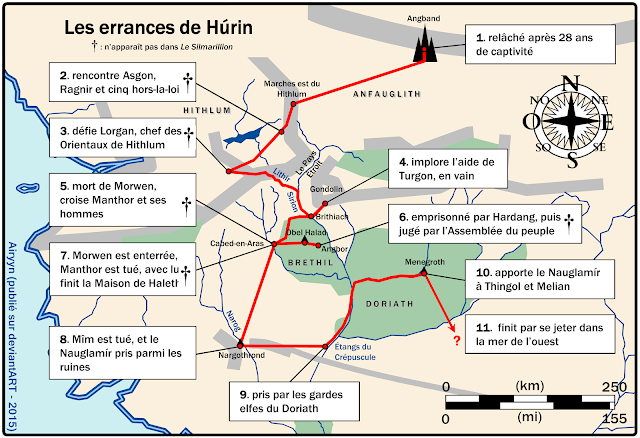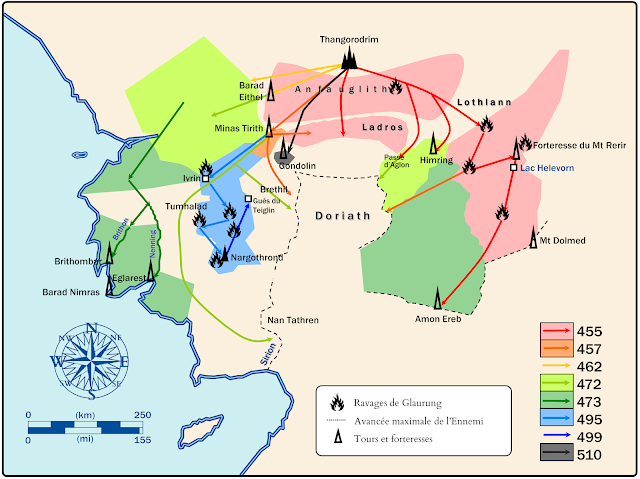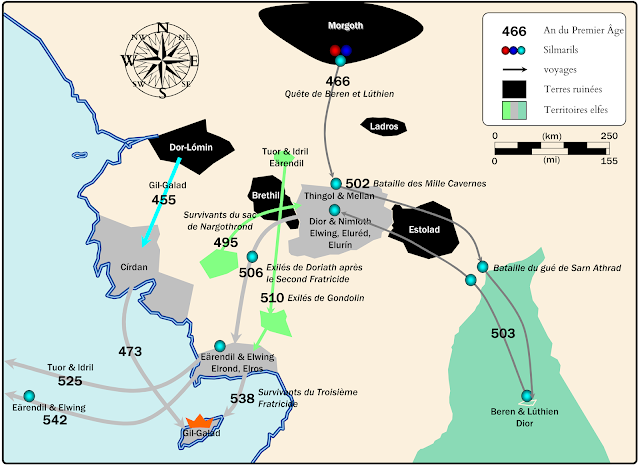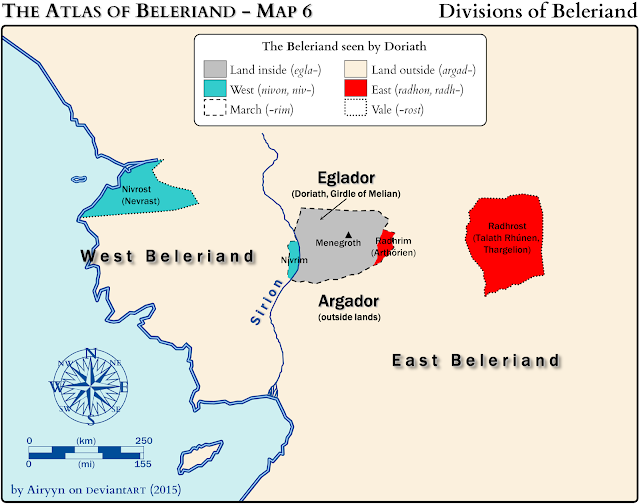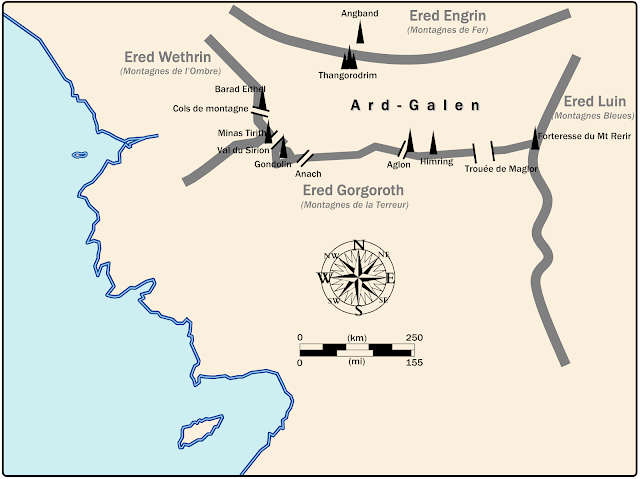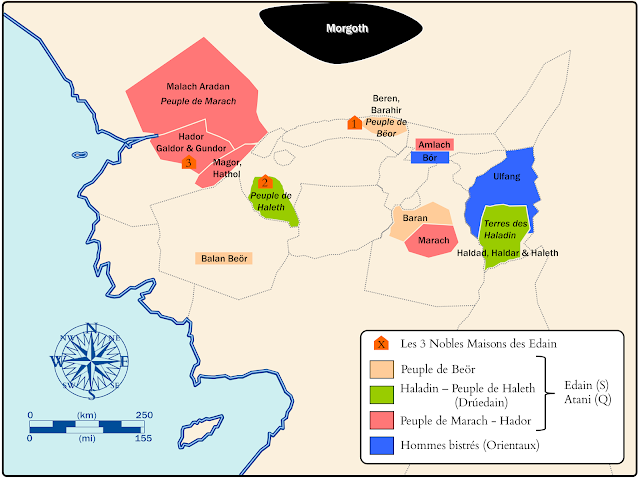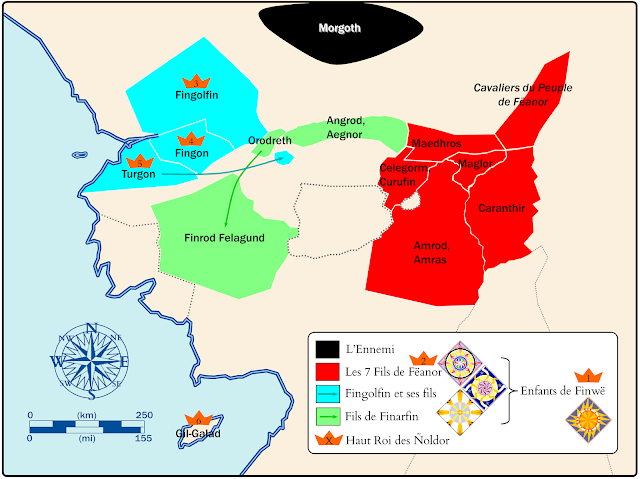(cliquez sur l'image pour l'agrandir)
Les Elfes Gris du Beleriand (Atlas du Beleriand - Carte 2)
Cette carte montre les royaumes des elfes
Teleri, qui étaient divisés principalement en deux groupes
: Sindar et
Laiquendi. Le mot elfique Sindar désigne la couleur grise, tandis que Laiquendi signifie "Elfes Verts". Leurs territoires figurent sur la carte en gris et vert, respectivement.
Les Sindar étaient en Beleriand bien avant l'arrivée des
Ñoldor, et Elwë Thingol était considéré comme leur régent. Quelques Sindar étaient installés en Mithrim [1], et d'autres en Nevrast [2]. Ceux-ci furent un peu bousculés par l'arrivée des
Ñoldor, et ceux de Nevrast suivirent Turgon en Gondolin ; le Nevrast resta vide.
En position centrale se trouve le Doriath, entouré par l'Anneau de Melian, qui subsista jusqu'au départ de celle-ci à la mort de son époux Thingol. Ce royaume forestier, aussi vaste que toute la Bretagne, était divisé en plusieurs parties : Brethil, Region, Neldoreth,
Nivrim, Arthórien et Brethil [4]. Après la Première Bataille, quelques Nandor s'installèrent en Arthórien [5], dont Ithilbor, le père du fameux Saeros qui fut tué par Túrin Turambar.
A l'est de Doriath, dans la ténébreuse forêt de Nan Elmoth, vivait Eöl ; cet elfe est souvent désigné comme Elfe Noir, mais cela n'a rien à voir avec les Elfes Noirs de la
fantasy. Eöl mourut tragiquement en Gondolin en l'an 400 du Premier Âge ; il est probable que la forêt de Nan Elmoth fut ensuite rattachée au Doriath.
Les Falathrim, qui résidaient sur la côte Est du Beleriand, étaient dirigés par Círdan, elfe bien connu des lecteurs du
Seigneur des Anneaux ; c'est lui qui possédait Narya, l'un des trois anneaux elfes. Celui-ci était aussi appelé Nōwë [3], dont la sonorité est proche du personnage biblique Noé.
***
A propos de l'Atlas du Beleriand
Cet
Atlas est une série de dix cartes (ou plus!) concernant la géographie,
l'histoire et la géopolitique dans le Beleriand, le territoire des
évènements du
Silmarillion.
Cette carte a été créée pour illustrer
un essai dédié à la géopolitique en Beleriand publié sur le site
JRRvf. La carte a été améliorée et ensuite
publiée sur Deviantart.
***
Détails techniques
Deux polices de caractères ont été utilisées : Franklin Gothic Medium et
Cardo de David J. Perry.
***
Bibliographie et référence
[1] HoMe XI pp 378,410
[2] Silmarillion XV p117, HoMe XI p45
"Then
Ulmo returned to the sea, and Turgon sent forth all his people, even to
a third part of the Noldor of Fingolfin's following, and a yet greater
host of the Sindar"
[3] HoMe XII p392
[4] Silmarillion XII p135
"Now
Brethil was claimed as part of his realm by King Thingol, though it was
not within the Girdle of Melian, and he would have denied it to Haleth"
[5] HoMe XI 112


